Monthly Archives: January 2018
 Whenever we make a trip to the emergency room, most of us find ourselves waiting impatiently for the myriad of tests to be returned from the lab to find out what is going on. And, most of us find that annoying, but when you think about how things used to be diagnosed, you might just find yourself rethinking those tests. Imagine a time when something like Pneumonia, Bronchitis, or Tuberculosis might have been “diagnosed” by having you doctor place his ear to your chest to see what you sound like. While I’m no expert, I have a pretty good idea that those three lung diseases would sound fairly similar. So if you had Tuberculosis and your doctor treated you for Bronchitis, how good would you expect your prognosis to be. Not very good, but this was all the doctor could do at that time.
Whenever we make a trip to the emergency room, most of us find ourselves waiting impatiently for the myriad of tests to be returned from the lab to find out what is going on. And, most of us find that annoying, but when you think about how things used to be diagnosed, you might just find yourself rethinking those tests. Imagine a time when something like Pneumonia, Bronchitis, or Tuberculosis might have been “diagnosed” by having you doctor place his ear to your chest to see what you sound like. While I’m no expert, I have a pretty good idea that those three lung diseases would sound fairly similar. So if you had Tuberculosis and your doctor treated you for Bronchitis, how good would you expect your prognosis to be. Not very good, but this was all the doctor could do at that time.
Enter René Théophile Hyacinthe Laennec (February 17, 1781 – August 13, 1826), a young man who’s mother died of tuberculosis when he was five years old. Laennec went to live with his great uncle the Abbé Laennec, who was a priest. As a child, Laennec became ill with Lassitude and repeated instances of Pyrexia. Laennec was also thought to have Asthma. At the age of twelve, he proceeded to Nantes, where his uncle, Guillaime-François Laennec, worked in the faculty of medicine at the university. Laennec was a gifted student. He learned English and German and began his medical studies under his uncle’s direction. Laennec knew first hand that 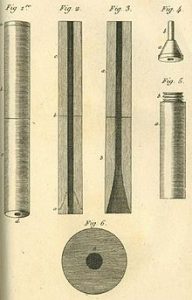 things like Tuberculosis can kill…he lived that nightmare with his mom. I am fairly certain that there were probably issues with her diagnosis too. After studying medicine, Laennec became a doctor. He also became a lecturer at the Collège de France in 1822 and professor of medicine in 1823. His final appointments were that of head of the medical clinic at the Hôpital de la Charité and professor at the Collège de France.
things like Tuberculosis can kill…he lived that nightmare with his mom. I am fairly certain that there were probably issues with her diagnosis too. After studying medicine, Laennec became a doctor. He also became a lecturer at the Collège de France in 1822 and professor of medicine in 1823. His final appointments were that of head of the medical clinic at the Hôpital de la Charité and professor at the Collège de France.
Laennec’s father was a lawyer, and he thought that being a doctor was a waste of René’s talents. With his father’s discouragement, René had a period of time during which he took long walks in the country, danced, studied Greek and wrote poetry. However, in 1799 he returned to study. Laennec studied medicine at the University of Paris under several famous physicians, including Dupuytren and Jean-Nicolas Corvisart-Desmarets. There he was trained to use sound as a diagnostic aid. Corvisart advocated the re-introduction of percussion during the French Revolution. In 1816, he was consulted by a young woman laboring under general symptoms of diseased heart, and in whose case percussion and the application of the hand were of little avail on account of the great degree of fatness. “The other method just mentioned [direct auscultation] being rendered inadmissible by the age and sex of the patient, I happened to recollect a simple and well-known fact, in acoustics…the great distinctness with which we hear the scratch of a pin at one end of a piece of wood on 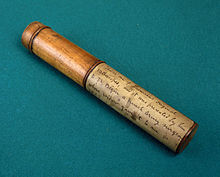 applying our ear to the other. Immediately, on this suggestion, I rolled a quire of paper into a kind of cylinder and applied one end of it to the region of the heart and the other to my ear, and was not a little surprised and pleased to find that I could thereby perceive the action of the heart in a manner much more clear and distinct than I had ever been able to do by the immediate application of my ear.” This situation started Laennec’s mind whirling, and before long, he had developed a simplistic version of what we now are all very familiar…the stethoscope. Ironically, like his mother, Laennec died of Tuberculosis on August 13, 1826. While I’m sure medicine had vastly improved during his lifetime, there was still no significant help for Tuberculosis.
applying our ear to the other. Immediately, on this suggestion, I rolled a quire of paper into a kind of cylinder and applied one end of it to the region of the heart and the other to my ear, and was not a little surprised and pleased to find that I could thereby perceive the action of the heart in a manner much more clear and distinct than I had ever been able to do by the immediate application of my ear.” This situation started Laennec’s mind whirling, and before long, he had developed a simplistic version of what we now are all very familiar…the stethoscope. Ironically, like his mother, Laennec died of Tuberculosis on August 13, 1826. While I’m sure medicine had vastly improved during his lifetime, there was still no significant help for Tuberculosis.
 For my nephew, Chris Iverson and my niece, Cassie Iverson, life has not always been easy. The birth of their oldest child, Lucas, born with Down’s Syndrome brought the beginning of a host of future medical bills, but anyone who knows Lucas can tell you that he is just the sweetest boy. His parents and family wouldn’t trade him for the world. Nor would his little sister, Zoey, who loves him to pieces, and inspires him to progress. Chris homeschools the kids, and lately he has been trying to incorporate some extra work with Lucas, because he is, of course behind other children his age, but he has the added handicap of ongoing medical treatments that have plagued him for a while now. Zoey is two and a half now, so she is at just the right age for starting pre-school, so Chris is starting with her ABCs now.
For my nephew, Chris Iverson and my niece, Cassie Iverson, life has not always been easy. The birth of their oldest child, Lucas, born with Down’s Syndrome brought the beginning of a host of future medical bills, but anyone who knows Lucas can tell you that he is just the sweetest boy. His parents and family wouldn’t trade him for the world. Nor would his little sister, Zoey, who loves him to pieces, and inspires him to progress. Chris homeschools the kids, and lately he has been trying to incorporate some extra work with Lucas, because he is, of course behind other children his age, but he has the added handicap of ongoing medical treatments that have plagued him for a while now. Zoey is two and a half now, so she is at just the right age for starting pre-school, so Chris is starting with her ABCs now.
In his spare time…when he can’t go fishing much…Chris is into video games, especially the online gaming. The 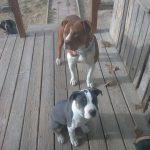 competition makes it much more fun than just going against the computer. Right now he is into Horizon Zero Dawn. Now, I can’t begin to tell you what these games are all about, but I would assume some kind of fighting game. Chris has also been training the family dogs, He wants to get them well behaved before too much longer, since they are already no longer puppies. Life for the Iverson family has had its ups, and its downs, but now there is a light at the end of the tunnel. Unfortunately, it too will come with its share of sadness.
competition makes it much more fun than just going against the computer. Right now he is into Horizon Zero Dawn. Now, I can’t begin to tell you what these games are all about, but I would assume some kind of fighting game. Chris has also been training the family dogs, He wants to get them well behaved before too much longer, since they are already no longer puppies. Life for the Iverson family has had its ups, and its downs, but now there is a light at the end of the tunnel. Unfortunately, it too will come with its share of sadness.
Chris and Cassie are currently planning a move to Tennessee. It’s not that they don’t love Powell, Wyoming, because they do. Powell has been their home for many years, if not all their lives, but with the medical needs of their son, and the opportunity for both of them to get an education and improve their lifestyle, they need to be in a more populated area that has  more to offer their special needs son. They have looked elsewhere, but there is nothing out there that is in Wyoming or even the surrounding states, so the move was inevitable. I know that their whole family will really miss them. It is always sad when your kids move away, but if it is the best thing for them, you have to simply let them go. I know that with Facebook, Skype, texting, and phone calls, they can stay close, and visits to Tennessee wouldn’t be the worst thing either. As for education, Chris plans to go to trade school to become a Plumber, and Cassie is planning to become a Real Estate agent…both occupations that will pay well, and provide for their family. While we will miss them, we also wish them the very best. Today is Chris’ birthday. Happy birthday Chris!! Have a great day!! We love you!!
more to offer their special needs son. They have looked elsewhere, but there is nothing out there that is in Wyoming or even the surrounding states, so the move was inevitable. I know that their whole family will really miss them. It is always sad when your kids move away, but if it is the best thing for them, you have to simply let them go. I know that with Facebook, Skype, texting, and phone calls, they can stay close, and visits to Tennessee wouldn’t be the worst thing either. As for education, Chris plans to go to trade school to become a Plumber, and Cassie is planning to become a Real Estate agent…both occupations that will pay well, and provide for their family. While we will miss them, we also wish them the very best. Today is Chris’ birthday. Happy birthday Chris!! Have a great day!! We love you!!
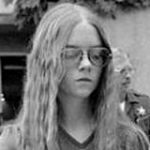 Unfortunately, these days, school shootings, while shocking every time, are not totally uncommon in this country. The reasons for the shootings vary, but are often blamed on bullying, loneliness, or anger for perceived wrongs. They never solve anything, least of all for the shooter, who is usually dead, or in prison after the heinous deed is done. The rest of the world is left wondering why, and how we can fix this. Of course, there are always the anti-gun advocates who say that the only solution is to take the guns out of the hands of the citizens, but as most sensible people know, guns don’t kill people, people kill people.
Unfortunately, these days, school shootings, while shocking every time, are not totally uncommon in this country. The reasons for the shootings vary, but are often blamed on bullying, loneliness, or anger for perceived wrongs. They never solve anything, least of all for the shooter, who is usually dead, or in prison after the heinous deed is done. The rest of the world is left wondering why, and how we can fix this. Of course, there are always the anti-gun advocates who say that the only solution is to take the guns out of the hands of the citizens, but as most sensible people know, guns don’t kill people, people kill people.
In 1979, I was a busy, young mother, when the first school shooting took place. The date was January 29, 1979. The place was Grover Cleveland Elementary School in San Diego, California. The shooter was 16 year old Brenda Spencer. I have to assume that she is some relation to me, as researchers have claimed that all the Spencers in the United States are related. That thought in itself makes me sad. People have the potential to become such great things, and there are so many wonderful things that a person could be the first to accomplish. So, why on that day, did young Brenda Spencer decide to take the lives of to men and wound nine children at the school across the street from her home. Her stated reasons were several…”I like red jackets,” “It livens up the day,” “I had no reason for it, and it was just fun,” “It was like shooting ducks in a pond,” “The children looked like a herd of cows standing around,” “It was really easy pickings,” And the one that stuck with the crime forever, “I just don’t like Mondays.” There is no good reason to decide to go out and kill people, but that last one stuck in my head. She didn’t like Mondays, so she ruined her own life, killed 2 men and wounded 9 children!!
Of course, I doubt if Mondays, red jackets, boredom, or animals had anything to do with it. In my opinion, the cause is mental illness. I’m not excusing her actions, because murder is a heinous crime. Brenda did not just wake up that day and decide to shoot up the school. She was a problem child, who was widely known as a drug abuser with a violent streak, such as repeatedly shooting BBs at the windows of the school. Still, her father gave her a .22 semi-automatic rifle and ammunition as a Christmas gift at the end of 1978. I’m sure he thought that her BB shooting was a harmless prank, but with the drugs and anger simmering inside her, he was wrong. She had started telling her classmates that she was going to do something “to get on TV.”
That January morning, as the children were entering the school, Brenda Spencer blazed away with rifle shots 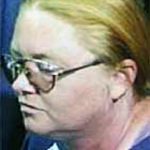 from her home directly across the street from the school. After 20 minutes of shooting, police surrounded Spencer’s home for six hours before she surrendered. Brenda Spencer had become the first person to commit a school shooting. Asked for some explanation for the attack, she simply said, “I just don’t like Mondays. I did this because it’s a way to cheer up the day. Nobody likes Mondays.” Spencer’s hatred for the first day of the school week was later memorialized by Bob Geldof, the leader of the rock group The Boomtown Rats, in the song, “I Don’t Like Mondays.” Spencer, who pled guilty to two counts of murder and assault with a deadly weapon, is currently serving a term of 25 years to life at the California Institution for Women in Corona, California, and she was denied parole four times, most recently in 2005.
from her home directly across the street from the school. After 20 minutes of shooting, police surrounded Spencer’s home for six hours before she surrendered. Brenda Spencer had become the first person to commit a school shooting. Asked for some explanation for the attack, she simply said, “I just don’t like Mondays. I did this because it’s a way to cheer up the day. Nobody likes Mondays.” Spencer’s hatred for the first day of the school week was later memorialized by Bob Geldof, the leader of the rock group The Boomtown Rats, in the song, “I Don’t Like Mondays.” Spencer, who pled guilty to two counts of murder and assault with a deadly weapon, is currently serving a term of 25 years to life at the California Institution for Women in Corona, California, and she was denied parole four times, most recently in 2005.
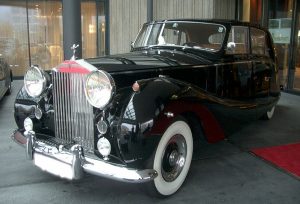 I don’t know…yet, if my son-in-law, Travis Royce has any connection to the Rolls-Royce families, but since my daughter, Amy Royce, and her husband Travis named their son Caalab Rolles Royce, I have felt a bit of a tie to the Rolls Royce vehicle line. Yes, my grandson’s middle name is spelled differently, but it makes it seem more like a last name and not a physical action. Because of my daughter’s family name, and my grandson’s name, I tend to read a story that is about the Rolls Royce. It just jumps out at me.
I don’t know…yet, if my son-in-law, Travis Royce has any connection to the Rolls-Royce families, but since my daughter, Amy Royce, and her husband Travis named their son Caalab Rolles Royce, I have felt a bit of a tie to the Rolls Royce vehicle line. Yes, my grandson’s middle name is spelled differently, but it makes it seem more like a last name and not a physical action. Because of my daughter’s family name, and my grandson’s name, I tend to read a story that is about the Rolls Royce. It just jumps out at me.
The Rolls-Royce cars are…high end elegance. They were first manufactured in 1904 By Henry Royce and Charles Rolls. These were not two men who were friends, and decided to build a car. Henry Royce was fourteen years older that Charles Rolls. He was a big, bearded, solid man, a workaholic and perfectionist, who worked hard for everything he had. As Rolls later said, he was “no ordinary man but a man of exceptional ingenuity and power of overcoming difficulties.” He was of Cambridgeshire farming stock…the son of a struggling miller. He had begun to earn money as a paper boy aged nine, somehow got an education at night school and took an engineering apprenticeship. Then he started an electrical engineering business in Manchester before designing and building his own car. It made an excellent impression for speed and reliability on a keen motorist named  Henry Edmunds, who knew Charles Rolls and more or less dragged him to meet Royce in Manchester. The two men became instant partners and agreed to form the Rolls-Royce car company. Rolls was so delighted with Royce’s quiet little two-cylinder car that he borrowed it on the spot, drove it back to London, woke Claude Johnson up in the middle of the night and insisted on giving him a ride in it. By the end of 1904 the first Rolls-Royces were came out, with the now characteristic radiator that would become the world’s best-known symbol of supreme motoring excellence.
Henry Edmunds, who knew Charles Rolls and more or less dragged him to meet Royce in Manchester. The two men became instant partners and agreed to form the Rolls-Royce car company. Rolls was so delighted with Royce’s quiet little two-cylinder car that he borrowed it on the spot, drove it back to London, woke Claude Johnson up in the middle of the night and insisted on giving him a ride in it. By the end of 1904 the first Rolls-Royces were came out, with the now characteristic radiator that would become the world’s best-known symbol of supreme motoring excellence.
The Silver Wraith was the first post-war Rolls-Royce. It was made from 1946 to 1958. It was designed for coachbuilders, and so was only a chassis. It was announced by Rolls-Royce in April 1946 as the 25/30 horsepower replacement for the 1939 Wraith in what had been their 20 horsepower and 20/25 horsepower market sector, that is to say Rolls-Royce’s smaller car. The size was chosen to be in keeping with the mood of post-war austerity. Even very limited production of the chassis of the larger car, the Phantom IV, was not resumed until 1950 and then, officially, only for Heads of State. The car had improvements, such as chromium-plated cylinder bores for the engine; a new more rigid chassis frame to go with new independent front suspension and a new synchromesh gearbox. The chassis now had centralized lubrication. The engine was a straight six-cylinder, which had been briefly made for the aborted by war Bentley Mark V. To this prewar mix Rolls-Royce added chromed bores. Initially, this engine had the Mark V’s capacity of 4,257 cc. It was increased from 1951 to 4,566 cc and in 1955, after the introduction of the Cloud, to 4,887 cc  for the remaining Silver Wraiths.
for the remaining Silver Wraiths.
Personally, I would love to find the connection between my grandson and Henry Royce, which I suspect exists. Of course, the whole family would be connected, but Caalab’s connection would be especially cool, because of the tie to his name. When he got old enough to think about cars, he told me that he was going to buy a 97 Rolls Royce for his name and birth year. I suppose he still could, but I think they are getting pretty scarce these days, at least for that specific year. Nevertheless, the Silver Wraith was never something Caalab was interested in, as far as I know.
 This past year found my niece, Lacey Stevens with a change of scenery, when she left Supercuts and moved on to the Ulta Beauty salon. Lacey is a wonderful cosmetologist with an awesome flair for the beautiful. When Lacey cuts your hair, it’s not just a cut, it’s a style upgrade. Lacey has cut and styled the hair of many of our family members, and they come out looking amazing.
This past year found my niece, Lacey Stevens with a change of scenery, when she left Supercuts and moved on to the Ulta Beauty salon. Lacey is a wonderful cosmetologist with an awesome flair for the beautiful. When Lacey cuts your hair, it’s not just a cut, it’s a style upgrade. Lacey has cut and styled the hair of many of our family members, and they come out looking amazing.
Lacey has been at Ulta Beauty now since March of last year, and it has been a wonderful year for her. She has made some wonderful friends in her co-workers, and has recently been give a promotion. She works with a great team of people and they all have a great time together. If you like the people you work with, it’s like you don’t work at all…you hang out with a great group of friends. And it doesn’t get better than that. Lacey has her own special style…in hair and in makeup, and she is very talented. While I think her hair cutting skills might be something she was born with, I think her makeup skills took a little practice. Of course, I’m picking on Lacey a little bit here, because that’s chocolate on her face, and definitely not makeup. Nevertheless, it is a very funny picture. Of course, it was her first birthday, and she had a great time covering her face with chocolate. These days, you wouldn’t find Lacey sporting that look…ever!!
Lacey is very social, which surprises me a little bit, because as a little girl, she was very shy. She had a small 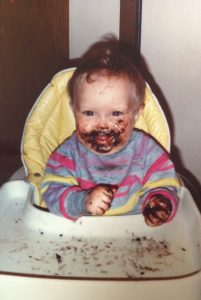 group of people she was close too, and a larger group of acquaintances, but as far as mist of us knew, Lacey was still pretty shy. I’m not sure exactly when it happened, but somewhere between junior high school and now, Lacey blossomed into a confident, and apparently, no longer shy, grown up woman. She has taken trips for training for work, which may not seem like much, but for a shy person…and I would know, going to those meetings, training sessions, and continuing education are nothing, if they aren’t stressful for the shy person, but as I’ve said, Lacey has changed a lot over the years. She has no problem talking to people these days.
group of people she was close too, and a larger group of acquaintances, but as far as mist of us knew, Lacey was still pretty shy. I’m not sure exactly when it happened, but somewhere between junior high school and now, Lacey blossomed into a confident, and apparently, no longer shy, grown up woman. She has taken trips for training for work, which may not seem like much, but for a shy person…and I would know, going to those meetings, training sessions, and continuing education are nothing, if they aren’t stressful for the shy person, but as I’ve said, Lacey has changed a lot over the years. She has no problem talking to people these days.
She has gone from being a cute little shy girl, to a beautiful cosmetologist who knows how to make others feel beautiful…not to mention look beautiful. And she is at kids at the right age to embrace the latest in hair color…wild colors and marveling. Now I’m probably never going to try these, but I think it looks cool on the younger generations. Today is Lacey’s birthday. Happy birthday Lacey!! Have a great day!! We love you!!
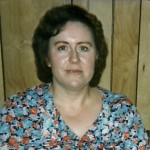 My husband’s aunt, Margee Kountz is his mother Joann Schulenberg’s youngest sister. When Joann developed Alzheimer’s disease, Margee was a vital part of our team of caregivers for her. Whenever I had to take my father-in-law, Walt Schulenberg to the doctor, Margee happily gave of her time to come and sit with her sister. People may not realize just how vital their visits can be. When a family of caregivers are working hard to keep their loved one in good health, the caregivers can find themselves feeling exhausted. That visit, while it make seem such a little thing, allows the caregiver time to get necessary things done, and a little bit of time to take a break from the work, and at least a little bit of the stress of caring for their patient. Caregiving is about love. You do it because to love your patient, but it is not without it’s stresses, worry, and exhaustion. The nice thing about the Respite Care worker is that they are a huge part of the team of people who perform two services…companionship for the patient and time off for the caregiver. They are priceless, and Margee always stepped up to help.
My husband’s aunt, Margee Kountz is his mother Joann Schulenberg’s youngest sister. When Joann developed Alzheimer’s disease, Margee was a vital part of our team of caregivers for her. Whenever I had to take my father-in-law, Walt Schulenberg to the doctor, Margee happily gave of her time to come and sit with her sister. People may not realize just how vital their visits can be. When a family of caregivers are working hard to keep their loved one in good health, the caregivers can find themselves feeling exhausted. That visit, while it make seem such a little thing, allows the caregiver time to get necessary things done, and a little bit of time to take a break from the work, and at least a little bit of the stress of caring for their patient. Caregiving is about love. You do it because to love your patient, but it is not without it’s stresses, worry, and exhaustion. The nice thing about the Respite Care worker is that they are a huge part of the team of people who perform two services…companionship for the patient and time off for the caregiver. They are priceless, and Margee always stepped up to help.
My mother-in-law, Joann passed away on January 4, 2018. We are no longer caregivers or respite care workers. She is at peace, but we are left behind to mourn her loss. For Margee, it means that she is the oldest member of the family…something she did not want to be. Not because of the age, but because it has been so hard for her to say goodbye to her older sisters. I think that in many ways she feels like “the last of one standing,” and that’s not what she ever wanted. I know the feeling. It is not so very much different from being orphaned, which happens to all of us when our parents pass away. Still, we hope our siblings will live, at least, close to as long as we do, because when your parents and your siblings are gone, you feel truly alone. Of course, Margee isn’t really alone. She has her children grand children, and a great grandson too, but there is just a strange feeling that goes along with being the last of the original family.
While Margee was a big part of taking care of her sister, and the caregivers who worked during those years, I’m not entirely sure she ever knew just how important she really was. She was, sort of, an unsung hero. I’m sure I could have taken my mother-in-law to my father-in-law’s doctor’s appointments, but it would have been 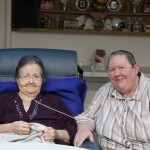 a huge undertaking for one person. Margee took half of that load off of me, and gave my mother-in-law a much needed social session too. She can to visit, and it gave my mother-in-law a new perspective on life. Their conversation stimulated her mind some. They talked about the old days, their kids, all the fun they had. They didn’t share their growing up years, because just six months after Margee was born, my in-laws were married. Nevertheless, there was much to talk about. Each could compare their childhood to the others, maybe. It wouldn’t really matter what they talked about, because after all, the visits were Margee’s gift of love for her sister. And that is what makes respite care priceless. Today is Margee’s birthday. Happy birthday Margee!! Have a great day!! We love you!!
a huge undertaking for one person. Margee took half of that load off of me, and gave my mother-in-law a much needed social session too. She can to visit, and it gave my mother-in-law a new perspective on life. Their conversation stimulated her mind some. They talked about the old days, their kids, all the fun they had. They didn’t share their growing up years, because just six months after Margee was born, my in-laws were married. Nevertheless, there was much to talk about. Each could compare their childhood to the others, maybe. It wouldn’t really matter what they talked about, because after all, the visits were Margee’s gift of love for her sister. And that is what makes respite care priceless. Today is Margee’s birthday. Happy birthday Margee!! Have a great day!! We love you!!
 When we think of the attack on Pearl Harbor, we mostly think of the events that took place at Pearl Harbor, but that attack was felt far and wide. I’m sure there are many stories, But this one struck me as particularly poignant. The Japanese bombing of the US naval base in Pearl Harbor 75 years ago sent a seismic shock around the world. Nicholas Best charts how stunned onlookers across the planet…from Dirk Bogarde to Adolf Hitler to Mao Zedong…reacted to the news. Their reactions might have been interesting, but I was moved by the thoughts and reactions of Joan Fawcett, who was simply a passenger on the Dutch ship Jägersfontein. Joan was just 21 years old that December 7th, and she was traveling to India from San Francisco. After several days at sea, she was looking forward to arriving in Honolulu soon after breakfast. Joan didn’t want to miss a moment as the ship approached the Hawaiian island of Oahu from the south.
When we think of the attack on Pearl Harbor, we mostly think of the events that took place at Pearl Harbor, but that attack was felt far and wide. I’m sure there are many stories, But this one struck me as particularly poignant. The Japanese bombing of the US naval base in Pearl Harbor 75 years ago sent a seismic shock around the world. Nicholas Best charts how stunned onlookers across the planet…from Dirk Bogarde to Adolf Hitler to Mao Zedong…reacted to the news. Their reactions might have been interesting, but I was moved by the thoughts and reactions of Joan Fawcett, who was simply a passenger on the Dutch ship Jägersfontein. Joan was just 21 years old that December 7th, and she was traveling to India from San Francisco. After several days at sea, she was looking forward to arriving in Honolulu soon after breakfast. Joan didn’t want to miss a moment as the ship approached the Hawaiian island of Oahu from the south.
Many other passengers were up early too. They were all enjoying the view of Diamond Head as they prepared to enter harbor. To add to the fun, the US navy was carrying out some sort of naval exercise ahead of them. As Joan later recalled: “I noticed a few puffs of grey smoke in the sky, just over the harbor, and as they seemed  strange clouds I asked the boys what explanation they could give and we decided that they were the puffs from anti-aircraft fire. By this time there were many grey spots and soon we could hear the report of the guns. We thought it was just a practice maneuver and a welcome salute for us. By nine o’clock we had had breakfast and were all up on deck watching the planes fly over. We did see things drop into the water, and one only 50 yards away, but thought nothing more of it. Later we heard eight bombs were aimed at our ship. We made a beautiful target for we were entering the harbor, and being in the mined area could not swerve left or right in the cleared channel. We were thoroughly enjoying the display.” The ship’s agent hurried aboard as soon as they docked. He told the passengers it was no exercise. The US Navy’s Pacific fleet up the coast at Pearl Harbor was being attacked by the Japanese. Within hours, news of the outrage was racing around the world, leaving people shocked, dismayed…and, in some cases, delighted…in its wake.
strange clouds I asked the boys what explanation they could give and we decided that they were the puffs from anti-aircraft fire. By this time there were many grey spots and soon we could hear the report of the guns. We thought it was just a practice maneuver and a welcome salute for us. By nine o’clock we had had breakfast and were all up on deck watching the planes fly over. We did see things drop into the water, and one only 50 yards away, but thought nothing more of it. Later we heard eight bombs were aimed at our ship. We made a beautiful target for we were entering the harbor, and being in the mined area could not swerve left or right in the cleared channel. We were thoroughly enjoying the display.” The ship’s agent hurried aboard as soon as they docked. He told the passengers it was no exercise. The US Navy’s Pacific fleet up the coast at Pearl Harbor was being attacked by the Japanese. Within hours, news of the outrage was racing around the world, leaving people shocked, dismayed…and, in some cases, delighted…in its wake.
Thinking about Joan Fawcett, I have wondered how she must have felt when she found out that they were 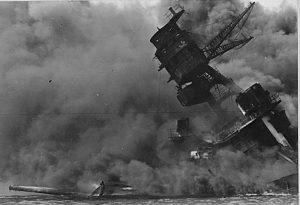 sailing right into a battle. She may not have known it at all until the agent rushed onboard to try to pull people to safety. Imagining the awe of the beautiful harbor, and then having the images dissolving into horror, fear, and death. Now she finds herself running for her life alongside all the other passengers, praying that they can get to safety before one of those bombs hits them. There is no place that is safe to go. It was chaos…everywhere. She and the rest of the passengers are caught in the middle of their worst nightmare, and they can never get those pictures out of their heads. Most of the people alive then, and anyone who has ever studied the attack, could never get that picture out of their head.
sailing right into a battle. She may not have known it at all until the agent rushed onboard to try to pull people to safety. Imagining the awe of the beautiful harbor, and then having the images dissolving into horror, fear, and death. Now she finds herself running for her life alongside all the other passengers, praying that they can get to safety before one of those bombs hits them. There is no place that is safe to go. It was chaos…everywhere. She and the rest of the passengers are caught in the middle of their worst nightmare, and they can never get those pictures out of their heads. Most of the people alive then, and anyone who has ever studied the attack, could never get that picture out of their head.
 When people think of going into space, most of them think of the “Race to Space.” John F Kennedy (1917-1963) who served as the 35th President of the United States, was president during the Cuban Missile Crisis, the Civil Rights Movement, and the beginning of the United States involvement in the Vietnam War. The race to space was his pet project, but he was not the first person to think about it. I think you would be very surprised to find out who the first person to propose space travel.
When people think of going into space, most of them think of the “Race to Space.” John F Kennedy (1917-1963) who served as the 35th President of the United States, was president during the Cuban Missile Crisis, the Civil Rights Movement, and the beginning of the United States involvement in the Vietnam War. The race to space was his pet project, but he was not the first person to think about it. I think you would be very surprised to find out who the first person to propose space travel.
The first proposal for space travel in English history was made by Oliver Cromwell’s brother-in-law, John Wilkins 1614-1672) a theologian and natural philosopher, who married Cromwell’s youngest sister Robina. Wilkins was a polymath of great learning and curiosity, and would be one of the founders of the Royal Society. In two books he explored the possibility of “flying chariots” to carry men to the moon. He believed, as did many others, that the moon and planets were inhabited, and that we should meet these people and trade with them. People were anchored to the earth by a type of magnetism, and if it were possible to reach an altitude of just 20 miles, travellers would be free to fly, or rather sail, though space. Breathing wouldn’t be a problem as the astronauts would soon grow accustomed to the purer air breathed by angels. Of course, we now know that the problem with the “air” in space was the lack of it, not the purity of it.
Apparently, Wilkins experimented in building flying machines with Robert Hooke, in the gardens of Wadham 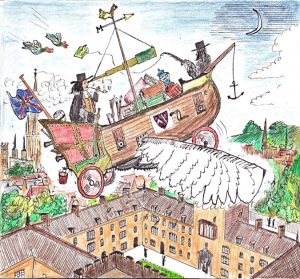 College, Oxford, in the 1650s. Some years later, however, with growing understanding of the nature of vacuums, he realised that space travel was much more complicated than he had first expected. I suppose it was a letdown in his philosophers mind, but the conclusion was inevitable, because as we all know space travel, while definitely possible, is not easy. It takes much scientific analysis and years of trial and error, but while it was not as easy as Wilkins thought it would be, he was on the right track after all. Nevertheless, Wilkins was not well known for his futuristic vision. While his Cromwellian connections reduced him to poverty after the return of the monarchy, Wilkins’s fortunes were gradually restored and he ended his life as Bishop of Chester.
College, Oxford, in the 1650s. Some years later, however, with growing understanding of the nature of vacuums, he realised that space travel was much more complicated than he had first expected. I suppose it was a letdown in his philosophers mind, but the conclusion was inevitable, because as we all know space travel, while definitely possible, is not easy. It takes much scientific analysis and years of trial and error, but while it was not as easy as Wilkins thought it would be, he was on the right track after all. Nevertheless, Wilkins was not well known for his futuristic vision. While his Cromwellian connections reduced him to poverty after the return of the monarchy, Wilkins’s fortunes were gradually restored and he ended his life as Bishop of Chester.
 The majority of earthquakes are minor and cause little damage, They are quite common, and for the most part, we never hear about them. On the other hand, on January 23, 1556 an earthquake hit Shaanxi, China. While this didn’t even come close to being the largest earthquake ever recorded, it remains the deadliest to this day. Scientific investigation revealed that the magnitude of the quake was approximately 8.0 to 8.3. The largest earthquake in history was the 1960 Valdivia earthquake, registering 9.4 to 9.6. The Valdivia was without doubt much larger that the Shaanxi China quake, but the size of a quake isn’t the only thing that makes it the worst.
The majority of earthquakes are minor and cause little damage, They are quite common, and for the most part, we never hear about them. On the other hand, on January 23, 1556 an earthquake hit Shaanxi, China. While this didn’t even come close to being the largest earthquake ever recorded, it remains the deadliest to this day. Scientific investigation revealed that the magnitude of the quake was approximately 8.0 to 8.3. The largest earthquake in history was the 1960 Valdivia earthquake, registering 9.4 to 9.6. The Valdivia was without doubt much larger that the Shaanxi China quake, but the size of a quake isn’t the only thing that makes it the worst.
The epicenter of the Shaanxi quake was in the Wei River Valley in the Shaanxi Province, near the cities of Huaxian, Weinan and Huayin. In Huaxian, every single building and home collapsed, killing more than half the residents of the city, a number estimated in the tens of thousands. It was a similar  story in Weinan and Huayin. In some places, 60-foot-deep crevices opened in the earth. Serious destruction and death occurred as much as 300 miles away from the epicenter. The earthquake also triggered landslides, which contributed to the massive death toll. In all, an estimated 830,000 people lost their lives in the Shaanxi earthquake. Counting casualties is often imprecise after large-scale disasters, especially prior to the 20th century, but this disaster is still considered the deadliest of all time.
story in Weinan and Huayin. In some places, 60-foot-deep crevices opened in the earth. Serious destruction and death occurred as much as 300 miles away from the epicenter. The earthquake also triggered landslides, which contributed to the massive death toll. In all, an estimated 830,000 people lost their lives in the Shaanxi earthquake. Counting casualties is often imprecise after large-scale disasters, especially prior to the 20th century, but this disaster is still considered the deadliest of all time.
The quake struck in late evening, with aftershocks continuing through the following morning. A magnitude 8.0 to 8.3 earthquake isn’t close to the strongest tremor on record. However, the quake struck in the middle of a densely populated area with poorly constructed buildings and homes, resulting in the horrific death toll. Even if the number of deaths caused by the Shaanxi earthquake has been overestimated slightly, it would still rank as the worst disaster in history by a considerable margin. The earthquake and tsunami in Indonesia in 2004 is  generally considered the second deadliest disaster in history.
generally considered the second deadliest disaster in history.
The local records indicate that, in addition to inspiring searches for the causes of earthquakes, this particular quake led the people in the region affected to search for ways to minimize the damage caused by such disasters. Many of the casualties in the quake were people who had been crushed by falling buildings. Thus, in the aftermath of the 1556 quake, many of the stone buildings that had been leveled were replaced with buildings made of softer, more earthquake-resistant materials, such as bamboo and wood. By all accounts, this was an earthquake like no other.
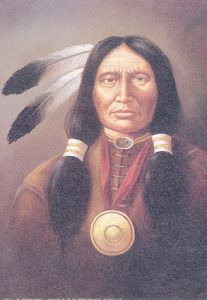 On this day, January 22, 1879, American soldiers were in pursuit of Cheyenne Chief Dull Knife and his people, who were making a desperate bid for freedom. The ensuing battle was a horrific defeat for Chief Dull Knife and his band. The soldiers effectively crushed the so-called Dull Knife Outbreak.
On this day, January 22, 1879, American soldiers were in pursuit of Cheyenne Chief Dull Knife and his people, who were making a desperate bid for freedom. The ensuing battle was a horrific defeat for Chief Dull Knife and his band. The soldiers effectively crushed the so-called Dull Knife Outbreak.
Dull Knife was a leading chief of the Northern Cheyenne tribe, and was sometimes called Morning Star. He had long urged peace with the powerful Anglo-Americans invading his homeland in the Powder River country of modern-day Wyoming and Montana. However, the 1864 massacre of more than 200 peaceful Cheyenne Indians by Colorado militiamen at Sand Creek, Colorado, led Dull Knife to question whether the Anglo-Americans could ever be trusted. He reluctantly led his people into a war he suspected they could never win. In 1876, many of Dull Knife’s people fought along side Crazy Horse and Sitting Bull at their victorious battle at Little Bighorn, but Chief Dull Knife did not participate.
During the winter after Little Bighorn, Dull Knife and his people camped along the headwaters of the Powder River in Wyoming. It was here that they fell victim to the army’s winter campaign for revenge. In November, General Ranald Mackenzie’s expeditionary force discovered the village and attacked. Dull Knife lost many of his people, and along with several other Indian leaders, reluctantly surrendered the following spring. In 1877, the 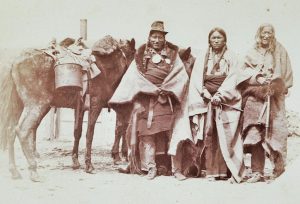 military relocated Dull Knife and his followers far away from their Wyoming homeland to the large Indian Territory on the southern plains, in what is now Kansas and Oklahoma. They were not allowed to practice their traditional hunts, the band was largely dependent on meager government provisions. Beset by hunger, homesickness, and disease, Dull Knife and his people rebelled after one year. In September 1878, they joined another band to make an epic march back to their Wyoming homeland. Although Dull Knife publicly announced his peaceful intentions, the government regarded the fleeing Indians as renegades, and soldiers from bases scattered throughout the Plains attacked the Indians in an unsuccessful effort to turn them back.
military relocated Dull Knife and his followers far away from their Wyoming homeland to the large Indian Territory on the southern plains, in what is now Kansas and Oklahoma. They were not allowed to practice their traditional hunts, the band was largely dependent on meager government provisions. Beset by hunger, homesickness, and disease, Dull Knife and his people rebelled after one year. In September 1878, they joined another band to make an epic march back to their Wyoming homeland. Although Dull Knife publicly announced his peaceful intentions, the government regarded the fleeing Indians as renegades, and soldiers from bases scattered throughout the Plains attacked the Indians in an unsuccessful effort to turn them back.
Arriving at Fort Robinson, Nebraska, near their Wyoming homeland, Dull Knife and his people surrendered to the government in the hopes they would be allowed to stay in the territory, but that was not to be an option. Administrators instead threatened to hold the band captive at Fort Robinson until they would agree to return south to the Indian Territory. Unwilling to give up when his goal was so close, in early January, Dull Knife led about 100 of his people in one final desperate break for freedom. Soldiers from Fort Robinson chased after the already weak and starving band of men, women, and children, and on January 22, they attacked and killed at 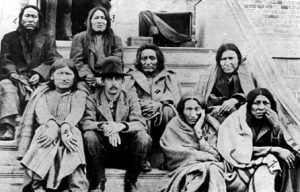 least 30 people, including several in the immediate family of Dull Knife.
least 30 people, including several in the immediate family of Dull Knife.
Badly bloodied, most of the survivors returned to Fort Robinson and accepted their fate. Dull Knife managed to escape, and he eventually found shelter with Chief Red Cloud on the Sioux reservation in Nebraska. Permitted to remain on the reservation, Dull Knife died four years later, deeply bitter towards the White Man he had once hoped to live with peacefully. The same year, the government finally allowed the Northern Cheyenne to move to a permanent reservation on the Tongue River in Montana near their traditional homeland. At last, Dull Knife’s people had come home, but their great chief didn’t live to join them.

